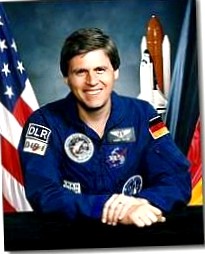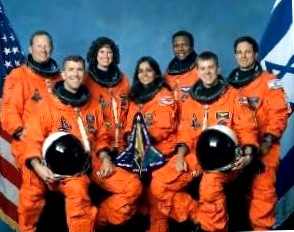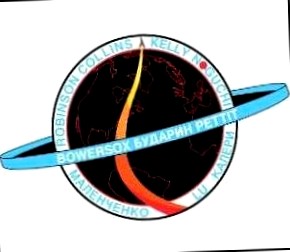Notes of the former German Columbia astronauts Ulrich Walter to the shuttle crash and the consequences
Dr. Ulrich Walter (49) was the last German science astronaut together with his colleague Hans Schlegel, who with the on the 1. February stunned NASA spatial trip Columbia under the D2 mission (26.4.-6.5.1993) in the orbit. His flight, which vintage in April this year for the tenth time, the physicist is still in good memory. The more Walter is affected by the Columbia mischief. In an interview aubert the ex-astronaut, the from the 1. April Waser for Space Technology at the Technical University of Munchen will take to the Columbia catastrophe and the future prospects of manned space travel.
Your Columbia mission STS-55 is in April for the tenth time. Become a bottle of sparkling wine to the celebration of the day or let the whole review on a thoughtful way?

Ulrich Walter
Walter: I will probably call my shuttle colleagues that have offered me to come to the states to commit the ten-year-old jubilaum together. For a flight to America, however, the effort was a bit too rough. Whether and how I will celebrate in Germany, I do not know exactly, but at least one bottle of champagne in my new institute will be sure. They were the last German Astronaut, who was with the Columbia in orbit. Probably therefore they are currently in the media omniprated. How many times have you been invited to interviews since Columbia mischiefs or consulted as an expert?
Walter: At recordings I have certainly done 20. There are also several telephone interviews. I can not say that exactly, you quickly lose the overview. About space – whether unmanned or mans – is only reported in the media only then, as soon as smaller disasters such as the Ariane-V false restart or coarse like the Columbia-mischief occurs. does this annoy you?
Walter: This is a typical human attitude. Let’s take a look at Apollo 13. When the first person landed on the moon as part of the Apollo 11 mission, the worldwide interest was still giant grob. But already at the second mission to the moon, at Apollo 12, the interest of people had already fallen far. At Apollo 13 even has little watching. Only as the legendary “problem” occurred, the world substitute Hythe back. So the people – so is humanity. The 112 shuttle flights took place in front of Columbia have given people a certain normality. But only when something happens, the people hound again. It is also a little bit of the voyeurs who says: good that I was not there; That could happen to me too! Were the questions of the media representatives not traversed voyeuristic?
Walter: Of course the question came “Mr. Walter, what went through the head as she was the first time from the Columbia catastrophe” quite frequently. Certainly, after I hoarded from the Columbia crash, my Columbia flight in mind. Of course, the interviews are mostly personal emotional aspects in the foreground, because this obviously interests people most. First, man comes, then the shuttle. I think that this is an important point of view with regard to the manned space travel. It gives her a different status. A special tragedy in Columbia displeased was that in July of the last year, the intended Columbia start of the now relevant STS-107 mission has been postponed at the last minute, because technicians in the testing of the lines in the fuel supply system at the sister Room Atlantis and Discovery Light-Power Anomalies (VGLSPACE Shuttle – Learning from Challenger Untchildren – Or: Fear Fleets still discovered with) in the form of hairlines have discovered cracks. At that time, the Columbia was retrospective on heart and kidneys. The more surprised that the relatively young Columbia highly likely to have fallen victim to a technical mistake.
Walter: The Columbia was not just young, she was rather away from being really old. From the pictured 100 missions, she has just completed 28. The supposedly high “age” Accordingly, the Columbia can hardly have been the cause of the fall. The causes of the youngest accident certainly have nothing to do with the age of the orbit, but certainly come out of very different corner. What do you think about the current NASA information policy?
Walter: Super. All material, what the NASA has, you can research on the internet. You can track the press conferences live there or subscribe to the press releases. The only thing a little store is that one is sometimes several NASA dependances or. Websites must descend to get to the desired information. What I think is very good, but that NASA is now also published those reports and points that speak against them, such as the report of Paul Fishbeck, who admitted in 1994, the NASA MOGE’s problems with the heat slacks not on the make light shoulder. The NASA was warned explicitly at this point. That’s why NASA preserves had simply have to say: “No, so we do not bring such a negative to our side”. But this message put the NASA surprisingly quickly into the net, where you can see that you have learned from early mistakes obviously and really does not take a leaf from the mouth – whether this is good or bad for your own publicity. This is an outdoors open information policy that I have a very barbit. On the recently published picture, which was recorded with a telescope of the US Air Force, the outline of the Columbia is only possible to recognize. The photo shows the Columbia in 80 kilometers high – about a minute before breaking. Supposedly on the image of anomalies in the area of the left support surface can be seen. Keep the present picture for meaningful?
Walter: Yes that’s it. I have analyzed the picture exactly. Since it was pretty coarse-grainy, I have converted it in such a way that you see the picture on that pixel-free type, as it was present in the telescope. If you look at this once more, then there are two things on. On the one hand, on the leading edge of the left angle seemingly something stands out. Whether this is a real anomaly is the question. For, for example, if the shuttle is transversely, it may be optically as if something else stood in the way, so that the impression arises, there is something else on the front edge, although it is in reality at a very different point. That’s why it’s very hard to judge if it is an anomaly. I do not believe this, because if there was really a damage here, then something had to be missed on the corner, because nothing can stand out against the hypershade air stream. On the other hand – and this is unevenly more important for me – one recognizes a shadow on the back of the left angle. And I believe that there is something more common, because if you compare this with the other aircraft, then it looks so that something is really out of the flying: not necessarily smoke, but somehow a swallow leaving a banner behind a flag. That’s actually significant and at the same time an indication that something was on the left avalanche. And if you keep in mind that the reception was made three minutes before the explosion, so in the middle of the phase, as all sensors on the fly rooted, then it is clear that at this point, in this area something garnished. Suppose the avalanche was de facto damaged. What could have effected this? You can say something to a precise cause?
Walter: You can say a lot, but not sure. There are still too many options that come into question. The NASA experts probably see this similarly. Otherwise they had hardly pulled so many causes in effect. There is talk of a broken heat protection sign, space scrap, from mini meteorites that have the spatial driving or even from unknown lightning phenomena that exist in the still quite unexplored Mesopause (PDF).
Walter: From the theories that are currently around, you can really not really notice any way right, although the theory of fallen foam from the external tank is the most convincing one. Some are certainly unlikely than this. The space mull (cf. Waste for all) for example. There are two possibilities here: Either the room rip of space mull was hit when she was still in climb – but then one had to see a snork in the recordings, but what was not visible. If it happens in space goods, then the whole shuttle had to turn through the impact. And that’s what the on-board computers and the NASA control center immediately see. This event has been registered immediately – it has been knocked immediately alarm. In addition, it is such that an incidence of a particle, which is gross as a centimeter, had had the impact force of several hand grenades. Such a part had the aircraft smashed smoothly. That’s how it warranted in the flight a serious damage that certainly noticed goods. On the other hand, the damage has been limited locally, so the heat lines then also have been damaged in the area of a fist grain – and the NASA wife that damage of to a few fist increases of the shuttle can not harm the atmosphere in the atmosphere. And that’s why I do not believe that the space mull was guilty of mischief, even if you can not completely remain it. But it is the less likely all possibility for me.

But at least there are 9000 cataloged space mull particles, not to mention the exorbitant high number of dark figures!
Walter: These approximately 9000 cataloged particles are usually coarse than 10 centimeters. There are special radar systems at the NASA that observe these parts and calculate their trains. If it comes to a foreclosed collision with such a part of a shuttle with such a part, then the spatial ripple flies an evasive price, a non-unobsome manover, which is carried out on about every fold shuttle flug. Since this is not happening, it had to be a particle less than 10 centimeters. Everything that is smaller than 10 centimeters is no longer recognizable by radar. And these are the really potential problems. In other words, the really critical particles have a rough of one to ten centimeters. However, there are quite many of them. You treasures this to 100.000 stucco. But the space is damned rough – and you can calculate how many times a collision occurs. There is also a burdens that says: Every few thousand missions, it comes to such a stroke. But because these particles have such an extremely high speed relative to the shuttle – about 45.000 kilometers per hour – the penetration force is enormous. Such a part suggests the aircraft and then does damage in the aircraft, while in the area where the entry is, a relatively small hole is created. Only on the other side, where the particle leaks, a relatively gross damage area arises. Inside your training program, NASA prepares the astronauts on the very worst scenario on the very worst scenario? If the possibility of a deadly accident is discussed?
Walter: not at all. There is no tradition at the NASA. The NASA philosophy is as follows: How do everything possible so that our astronauts return to salvation again – and they must resume salvation. And this was already at Apollo times like this: In other words, the famous poison capsules are legend. As a astronaut, in the shuttle with the feeling, it rises that nothing happens, which in turn does not remember that something can happen. But internal conviction is here. And this is an important difference. If I was in the shuttle with poison capsules, this would be a completely different feel. That’s enough for the NASA reason enough to say: No, we do not do that! This is a psychologically very important point. However, I also think that a psychological preparation is not necessary, because everyone who applies to the NASA as Astronaut is in advance of the fact that space travel is always a dangerous company. Each astronaut wife already before applying, that he has to accept a calculated risk. Of course there is a very detailed emergency training at NASA. Estimated 80 percent of the entire training work with emergency situations. For example, a total failure of a shuttle is simulated in eight kilometers high. Trained is then how to come back to salvation – for example with a parachute. However, NASA requires in these scenarios that the astronauts actually have a real chance to react or act accordingly at all. So the shuttle should have a stable flight, so do not kill. But all this did not hit Columbia mischief. The spaceship was indeed no longer controllable. US Prasident Bush has slightly increased the budget for NASA and recently urges an early continuation of the shuttle program. Burven this development?
Walter: US Prassident George W. Bush has initially provided $ 500 million to NASA 500 million dollars. This sum only needs the US space residence to the cause analysis of the Columbia Disaster and for the following problems. This devours a lot of money. But this money was far from rich to realize any amendments on the shuttle system or even build a new shuttle.

What consequences does the Columbia catastrophe for further maintenance of the ISS?
Walter: The international space station can exist for anything without shuttle. An important point is that the regular progress supply ships also keep the ISS in orbit and increase. Since the progress the team regularly with food etc. can supply, thus keeping the space station at the lowest level. A disadvantage is certainly that you can not bring experiments to the space station and back. In addition, at least two manned sojus flights will be going to the room station this year – then it will certainly come to the crew change. Will the ISS of your shredded role as a springboard to Mars can still be fair?
Walter: I do not think the ISS will be the springboard to Mars. This idea came originally from Werner of Braun. I think that the so-called Mars Reference Mission Plan of NASA, after which the required spaceship was built in the Erdorbit and the expedition to the red planet is also started from there and directly to Mars, which is of all the most constructive. Need the space trip such a vision? Do we need a manned Mars expedition?
Walter: Definitely yes. Of which the space ride lives. Surely; You always have to knock on whether such a company is realizable and realistic. The space ride lives from the vision of the morning – and not remembrance of the past. A journey to the red planet has probably only be feasible in the context of an international effort. Believe that this will interfere with the nations?
Walter: Naturally. Look at the Euro only. This is from a vision of some governments to create a common safeguard. Only such visions bring something in the long term. (Harald FenceTo)